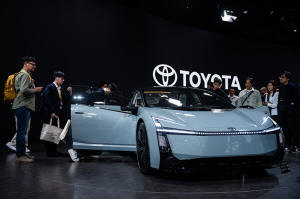Tokyo auto show highlights technology but Trump's tariffs loom large
[October 30, 2025] By
YURI KAGEYAMA
TOKYO (AP) — The Tokyo Mobility Show is highlighting more than just cars
or the types of fuel they use from electric to hydrogen, but also
various kinds of futuristic transport.
Think scuttling robotic chairs, like the Uni-One from Honda Motor Co.
The Tokyo-based maker of the Accord sedan says it is all about personal
mobility as a mode for quick transport by 2035. Just sit on the boxlike
machine as it zips around quietly.
Toyota Motor Corp. showed a helicopter-like aircraft with six
propellers, which was still in development in cooperation with U.S.
aviation company Joby.
Such gadgetry, as well as more regular vehicles, are on display at the
show, which runs through Nov. 9 at Tokyo Big Sight exhibition space. It
was previewed to media Wednesday, ahead of its opening to the public
Thursday.
Looming in the backdrop of the fanfare is the threat of auto tariffs
under U.S. President Donald Trump, raised to 15% from 2.5%, although an
improvement from the 25% he slapped on initially.
Trump’s tariffs are expected to erase more than 2 trillion yen ($13
billion) off automakers’ annual operating profits, according to
calculations from recent earnings.
Masahiro Moro, chief executive of Mazda Motor Corp., among the worst hit
of the Japanese automakers, said his engineers were developing cars that
understood drivers’ emotions, as well as those that contribute to
sustainability by reducing carbon emissions the more you drove.
“We believe the joy of driving has the power to shape the future,” he
told reporters.

Nissan Motor Corp. showed a prototype, or experimental model, of its
Sakura electric car, fitted with a solar-system roof that slides out at
the top, called “Ao-Solar Extender,” to generate power while the car is
parked. The word “ao” means “blue” in Japanese.
Nissan said the model’s message is about adding value to one’s life, as
the generated power can be used for other gadgets around the house as
well as work as power stations during disasters. The concept car targets
environmentally conscious moms, according to Nissan.
“Japan is at the center of what we do because we are a Japanese
company,” Nissan Chief Ivan Espinosa said on the sidelines of the show.
While in town earlier this week for talks with new Prime Minister Sanae
Takaichi, Trump also met with the heads of Japan’s businesses, including
Espinosa. The exchange of ideas was constructive, according to Espinosa.
[to top of second column] |

Members of the media and guests look at Toyota's Corolla concept
during the press day of the Japan Mobility Show, in Tokyo, Thursday,
Oct. 30, 2025. (AP Photo/Louise Delmotte)
 Nissan, as well as Toyota, said they
were considering importing their own models made in the U.S. back
into Japan as a way to mitigate the trade imbalance.
The Japanese government has promised to buy Fords and invest $550
billion in the U.S.
Japanese automakers export more than a million
autos to the U.S., while selling 4.4 million vehicles a year in
Japan. Only about 16,000 American cars were sold in Japan, a tiny
fraction of the Japanese auto market. Japanese cars make up about
40% of the American market, according to Cox Automotive, although
much of the vehicles sold there are made at U.S. plants.
Toyota Chief Executive Koji Sato said customers’ tastes differed by
markets, and offerings must be tailored to meet various needs.
“We want to be an important part of the American auto industry with
a long-term perspective,” he told a small group of reporters.
Toyota showed a still-developing tiny collapsible electric bicycle
called Land Hopper that Japan’s top automaker suggests should get
packed in the upcoming Land Cruiser FJ, the latest version of the
hit recreational vehicle that had its beginnings in 1951 as the
Toyota BJ.
A flagship model, Land Cruiser sales have topped 12 million in 190
countries and regions. Targeting Japanese off-roaders, the new Land
Cruiser FJ goes on sale in Japan next year — with a 2.7-liter
(1-gallon) gasoline engine.
Japanese exports to the U.S. have risen in recent months as
automakers tried to beat the tariffs. The crunch is expected to hit
next year.
“Automakers will look to increase U.S. production where possible and
diversify export destinations to other key markets, such as
Australia and Canada,” said Darcey Bowling, auto analyst at BMI.
“We expect that Japan’s vehicle market will face challenges due to
the elevated U.S. tariffs.”
All contents © copyright 2025 Associated Press. All rights reserved |